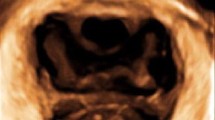Abstract
Introduction and hypothesis
Childbirth-related morphological abnormalities or defects of the puborectalis muscle (“avulsion”) can be diagnosed by magnetic resonance imaging and three-dimensional (3D) ultrasound, but neither method is universally available. In this study, we tested validity and reproducibility of a new method for diagnosing levator avulsion by 2D translabial ultrasound.
Methods
Seventy-five women were examined for major morphological abnormalities of the puborectalis muscle by palpation, 2D and 3D ultrasound (US). For 2D US, we used an oblique parasagittal translabial approach. The operator using 2D US was blinded against all other findings.
Results
Agreement between observers for diagnosis of avulsion by 2D US was 87% (Cohen’s kappa 0.56, CI 0.33–0.80). Agreement between tomographic 3D US and 2D US was 87% (kappa 0.61, CI 0.45–0.77).
Conclusions
Defects of the puborectalis muscle can be diagnosed with 2D US. The finding of a discontinuity between the hyperechogenic muscle and the pelvic sidewall is moderately reproducible and agrees moderately well with palpation and 3D US.



Similar content being viewed by others
References
Dietz H, Lanzarone V (2001) Levator trauma after vaginal delivery. Obstet Gynecol 106:707–712
Dietz H, Simpson J (2008) Levator trauma is associated with pelvic organ prolapse. Br J Obstet Gynaecol 115:979–984
DeLancey J, Morgan D, Fenner D, Kearney R, Guire K, Miller JM et al (2007) Comparison of levator ani muscle defects and function in women with and without pelvic organ prolapse. Obstet Gynecol 109:295–302
Dietz HP, Shek KL (2008) Validity and reproducibility of the digital detection of levator trauma. Int Urogynecol J 19:1097–1101
Kearney R, Miller JM, Delancey JO (2006) Interrater reliability and physical examination of the pubovisceral portion of the levator ani muscle, validity comparisons using MR imaging. Neurourol Urodyn 25:50–54
Dietz HP, Steensma AB (2006) The prevalence of major abnormalities of the levator ani in urogynaecological patients. BJOG: Int J Obstet Gynaecol 113:225–230
Bernstein IT (1997) The pelvic floor muscles: muscle thickness in healthy and urinary-incontinent women measured by perineal ultrasonography with reference to the effect of pelvic floor training. Estrogen receptor studies. Neurourol Urodyn 16:237–275
Dietz H (2007) Quantification of major morphological abnormalities of the levator ani. Ultrasound Obstet Gynecol 29:329–334
Dietz H, Shek K, Clarke B (2005) Biometry of the pubovisceral muscle and levator hiatus by three-dimensional pelvic floor ultrasound. Ultrasound Obstet Gynecol 25:580–585
Guaderrama N, Liu J, Nager C, Pretorius DH, Sheean G, Kassab G et al (2006) Evidence for the innervation of pelvic floor muscles by the pudendal nerve. Obstet Gynecol 106:774–781
Yang J, Yang S, Huang W (2006) Biometry of the pubovisceral muscle and levator hiatus in nulliparous Chinese women. Ultrsound Obstet Gynecol 26:710–716
Hoff Braekken I, Majida M, Ellstrom Engh M, Dietz HP, Umek W, Bo K (2008) Test- retest and intra-observer repeatability of two-, three- and four- dimensional perineal ultrasound of pelvic floor muscle anatomy and function. Int Urogynecol J 19:227–235
DeLancey J (2005) The hidden epidemic of pelvic floor dysfunction: achievable goals for improved prevention and treatment. Am J Obstet Gynecol 192:1488–1495
Otcenasek M, Krofta L, Baca V, Grill R, Kucera E, Herman H et al (2007) Bilateral avulsion of the puborectal muscle: magnetic resonance imaging-based three-dimensional reconstruction and comparison with a model of a healthy nulliparous woman. Ultrasound Obstet Gynecol 29:692–696
Abdool Z, Shek KL, Dietz HP (2008) The effect of levator avulsion on hiatal dimension and function. In print, Am J Obstet Gynecol
Dietz HP, Shek C (2008) Levator avulsion and grading of pelvic floor muscle strength. Int Urogynecol J 19:633–636
Acknowledgments
Prof. H.P. Dietz has received honoraria as a speaker from GE and AMS and has acted as consultant for CCS and AMS. He has also received equipment loans from GE, Toshiba and Bruel & Kjaer. Dr. K.L. Shek has no conflict of interest to declare.
Conflicts of interest
None.
Author information
Authors and Affiliations
Corresponding author
Rights and permissions
About this article
Cite this article
Dietz, H.P., Shek, K.L. Levator defects can be detected by 2D translabial ultrasound. Int Urogynecol J 20, 807–811 (2009). https://doi.org/10.1007/s00192-009-0839-4
Received:
Accepted:
Published:
Issue Date:
DOI: https://doi.org/10.1007/s00192-009-0839-4




